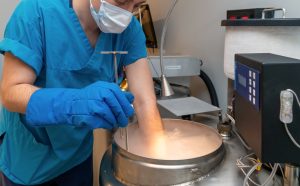Graves’ disease is an autoimmune disorder which causes hyperthyroidism, the overproduction of thyroid hormones. The disease usually affects young and middle-aged women who are genetically predisposed.
What causes hyperthyroidism?
Graves’ disease occurs when the immune system attacks the thyroid, causing it to become overactive. Thyroid stimulating immunoglobulins (TSIs) are circulating auto-antibodies that bind to receptors in the thyroid gland called thyrotropin receptors. This causes the thyroid gland to grow and thyroid follicles to secrete large amounts of thyroid hormones. The two main thyroid hormones, triiodothyronine (T3) and thyroxine (T4), are being excessively produced in Graves’ disease.
Symptoms
Graves’ disease has a wide range of symptoms and can present in varying degrees of severity in different patients. These symptoms may include:
- Weight loss despite normal appetite
- Puffy eyes (ophthalmopathy/thyroid eye disease), conjunctival irritation, lid retraction
- Enlarged and smooth thyroid gland (goitre)
- Difficulty concentrating on tasks
- Fast or irregular heart rate
- Hand tremors
- Heat sensitivity
- Anxiety and irritability
- Sweating
- Difficulty sleeping
Complications
Patients with Graves’ disease usually present with Graves’ ophthalmopathy that causes swelling of the eyes to appear to bulge or protrude outward. Since most of the eye is exposed, it causes dryness and irritation of the eye. Excessive strain on the optic nerve can also cause vision loss.
Patients who have Graves’ disease are also prone to other autoimmune diseases such as:
- Vitiligo
- Type 1 diabetes
- Systemic sclerosis
- Myasthenia gravis
- Rheumatoid arthritis
- Systemic lupus erythematosus (Lupus)
A pregnant woman with Graves’ disease may also pass on the thyroid autoantibodies to the foetus, which could lead to temporary hyperthyroidism in the newborn.
Thyroid storms or thyrotoxic crises are life-threatening situations where there is a sudden increase in thyroid hormones.
In patients that are untreated, Graves’ disease can lead to heart rhythm disorders that can lead to heart failure.
Diagnosis
A complete blood count is usually conducted when signs of infection are present. Thyroid-stimulating hormone (TSH) screening is done with third-generation thyrotropin assays that are very sensitive. The classic presentation of markers indicative of Graves’ disease include suppressed TSH and elevated T3 and T4 levels.
Low thyroid stimulating hormone (TSH)
A TSH test can measure the amount of thyroid-stimulating hormones (TSH) in the blood. The normal range is between 0.4 and 4.0 mU/L. TSH levels lower than 0.4-0.5mU/L indicate hyperthyroidism.
If the thyroid gland is secreting excessive amounts of hormone, the pituitary gland, a major endocrine gland in the brain responsible for controlling growth, produces lower levels of TSH. If a person has low TSH levels, the clinician will run tests for the following two markers to check for antibodies and specific thyroid hormones.
High levels of free T4
T4 is the main form of thyroid hormone that circulates in the blood. Therefore, elevated T4 levels may indicate hyperthyroidism and other thyroid problems such as thyroiditis or toxic multinodular goitre. A high level of proteins in the blood may also cause T4 levels to be high, which is why other markers are needed in the diagnosis of hyperthyroidism.
High levels of free and total T3
Persistently high levels of serum Triiodothyronine (T3) levels are indicative of hyperthyroidism and help to determine the severity of the hyperthyroidism. Generally, T3 levels are higher than T4 levels.
Positive Autoantibodies
Other laboratory tests that help to distinguish Graves’ disease from other autoimmune diseases include the detection of these autoantibodies:
- Thyroid stimulating hormone receptor antibody (TRAb) is considered the gold standard in the diagnosis of Graves’ disease.
- Thyroid stimulating immunoglobulin (TSI) is another autoantibody that is diagnostic for Graves’ disease. In patients with Graves’, white blood cells (CD4+ T lymphocytes) induce antibody producing cells (B cells) to produce thyroid-stimulating immunoglobulins (TSI) against thyroid-stimulating hormone receptors (TSH-R). It acts like TSH and stimulates unrestrained thyroid hormone production.
- Anti-thyroid peroxidase antibody (anti-TPO) is an autoantibody that suggests the cause of thyroid disease and is commonly found in patients with Graves’ disease and Hashimoto’s disease.
Treatment
Graves’ disease is a lifelong condition that requires long-term medication to regulate proper function of the thyroid gland. Treatment will mainly revolve around reducing thyroid hormone levels to prevent long term complications.
Beta blockers such as propranolol and metoprolol are usually the first line of treatment. They help to relieve sweating, anxiety and calms rapid heart rate.
Antithyroid drugs help to target the reduction of thyroid hormone production by inhibiting thyroid peroxidase (TPO). This helps to regulate normal thyroid function.
Radioactive iodine therapy is an effective treatment taken orally in the form of either liquid or capsules. Radioactive iodine 131 in the medication destroys most or all thyroid cells to eliminate symptoms of hyperthyroidism. The biggest side effect in taking this medication is the risk of developing hypothyroidism in the long run.
Surgical removal
Thyroidectomy is the surgical removal of the thyroid gland that can help to treat severe cases of hyperthyroidism and in cases that indicate the presence of thyroid nodules which suggest cancer. This mode of treatment is helpful for those who experience frequent episodes of severe swelling of the neck and patients that are unable to take beta blockers, such as those who are pregnant.
Conclusion
Being aware of the symptoms related to hyperthyroidism can help one to seek medical attention faster. Without treatment, potentially fatal health complications such as stroke and heart failure may ensue.













